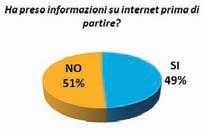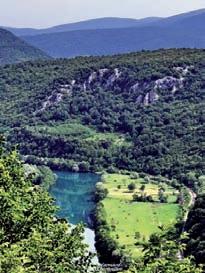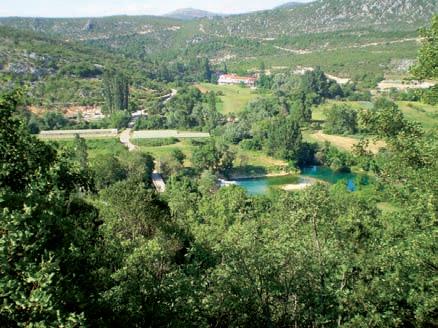
17 minute read
SWOT ANALYSIS OF THREE RIVER VALLEYS (UNA, NERETVA AND DRINA
ANALYSIS OF TOURIST OFFER
Breakdown of Tourists per Nationality
Advertisement
Nacionalnost Italija Hrvatska
14,437 11,730 R. Srpska 8,622 R. Srpska (iseljenici) 3,18 BiH 5,815 BiH (iseljenici) 5,113 Slovenija 9,725 Njemačka 8,622 Srbija 5,113 Srbija(iseljenici) 2,36 Švedska 3,910 Francuska 2,77 Norveška 2,77 Austrija 2,36 Nizozemska 2,36 Kanada 1,64 Velika Britanija 1,64 Mađarska 1,64 USA 1,64 Ostale zemlja 3,910 Nepoznato 1,64 100,0257
e majority of interviewed tourists were from Italy and Croatia. In the FBiH and the Serb Republic, there was a total of 14.4% of tourists that were considered to be “domestic.” To that number, we should add 8.2% of emigrants from both entities.
If we sum up the number of tourists from Croatia (11.7%), Slovenia (9.7%), Serbia including BiH emigrants (7.4%) and BiH with emigration (22.5%), we will get the percentage of 44.3% of the tourists who are originally from ex-Yugoslav countries. at percentage is probably even higher because some of the emigrants were not even reported as tourists.
Age Structure of Tourists
e numbers are fairly even balanced when it comes to the structure of guests, with male tourists being in a slight lead. As for the age structure, there is a prevalence of young people with even 56% of all tourists being age 16 to 34 and 74% age 16 to 44.
Main Destinations
According to the poll, 41 respondents (16%) were planning to make an overall tour of BiH or some other Balkan country, 10 respondents (4%) picked Banja Luka as their main holiday destination, while the remaining 7 (3%) were headed for Sarajevo. e majority of 141 respondents (55%) instead chose one of the places in the Valley as their main holiday destination.
Place of Last Overnight Stay
e answers to this poll question corroborate the fact that excursion tourism is scarce in our area, because 73% of respondents said their last place of overnight stay was one of the locations in the valley. erefore, as can be concluded from this fact, this is not the case of excursion tourism, but mostly phased tourism, which was explicitly stressed in 16% of cases.
Type of Accommodation
In view of accommodation capacities, the majority of tourists prefer private houses and only 40% of them stay in hotels or boarding houses. e places with highest incidence of overnight stays in professional tourist facilities, hotels or boarding houses, are Prijedor, Kozara Park, Martin Brod and Bihać. e biggest number of overnight stays in private houses is recorded in the Prijedor area and then in Kulen Vakuf.
Main Means of Transportation
A car is by far the most common means of transportation of holiday makers in the Una-Sana area and is followed by a plane and a bus. ere are also a certain number of tourists who travel by bike (3%). e majority of tourists who arrive by plane are guests from Sweden, Germany and the USA. e biggest number of arrivals is via Zagreb airport (160 km away) and then via Banja Luka airport.
Length of Tourist Stays in BiH
e answers to this poll question revealed an important fact, which is “longer” rest because most respondents claim to have spent over a week on holidays, with 85% of them spending at least 4 days. If we compare the length of stays and the nationality of tourists, we’ll come to the surprising revelation that “domestic” guests (33.1%) take longer vacations, which points to the fact that emigrants probably go on holidays in their new country of residence. It has to be noted that 70% of respondents from this subsample stay in private houses, in contrast to the 54% of respondents in the overall sample.
“Is is Your First Visit to BiH?”
e purpose of this question is to nd out if respondents have already been to BiH before. All those who declared to be BiH nationals (including the Serb Republic) replied with “no”. A large percentage of those who replied with “no” (80%) came from one of the ex-Yugoslav countries. A large number of respondents who also replied with “no” came from other countries, so that the total number of visitors who had been to BiH before was about 70%. is tells us about a high incidence of tourists from the Diaspora, as well as about a large number of tourists from the neighboring countries.
Organization of Travel
In largest number of cases, travel was self-organized by tourists themselves. is is an example of individual tourism with little or no intercession from travel agencies and tour-operators, which can be explained by the age structure of tourists who mostly happen to be young people. e share of the so-called “association tourism,” linked with di erent sports events, primarily those of humanitarian nature, is not negligible either. e latter is a classic example of “responsible and solidarity” tourism and makes 9% of all tourist travel, in contrast to 2% of tourist activities of di erent sports teams.
Choice of Destination

e poll involved three groups of respondents: BiH nationals, nationals of the ex-Yugoslav countries and nationals of other countries. eir replies suggest that advice by friends, that is, “verbal recommendation,” was decisive in their choice of holiday destination. Respondents from the rst two groups named a concrete place in the Una-Sana region as their holiday destination. In the majority of these cases, respondents were visiting family members, relatives or friends. In the group of respondents from “other countries”, there is an interesting percentage (25%) of those who
indicated the internet as the source of information that helped them with their choice of holiday destination. e graph on the side illustrates the role of the Internet, with almost a half of all respondents claiming to have used the Internet to get travel-related information. Such a high percentage of internet users in this speci c case can be explained by their age, since the majority of interviewed tourists are young people.


Towns in BiH that have or will be visited

e question was poised to give us an answer about the nationality of guests who most o en chose the Una-Sana valley as their holiday destination. Not surprisingly, the region’s center, Banja Luka, turned out to be the most frequented destination, with Sarajevo and Mostar lagging slightly behind, which can be explained by their geographic distance from the region. We grouped destinations into three macro-regions, Prijedor, Bihać and Mrkonjić Grad, in order to nd out which places were the most popular among tourists. Kozara National Park proved to be the most alluring destination, but the other two were just as interesting to the visitors. Taken together, all three destinations account for 78% of all tourist interests.

Most popular holiday activities
e answers to this poll question are not expressed in percentages, but in absolute values, given the fact that the respondents were o ered a number of answers. e poll results revealed that holiday activities connected with the river were an absolute hit. e clientele of this are dynamic and young people, with o en a pronounced strong interest in sports activities. Only 70 respondents (23%) did not select any of the options o ered. e majority of respondents indicated that a visit to family members or friends was the main reason for their travel.

Overall assessment of destination (AV)
Respondents from the sample were asked to give an overall rating and impression about BiH. We singled out those respondents who were visiting BiH for the rst time, since their opinion seemed to particularly matter. Some 60% of interviewees gave BiH a “very good” rating, while the number of respondents from the subsample who gave BiH identical rating exceeds 60%. is is a very good sign. Negative ratings were indeed few.
Analytical assessment of the Individual factors in touristic o er
Natural beauties are the number one attraction, followed by the cuisine and mentality of local people. Road infrastructure and touristic post signs were assessed as unsatisfactory.
Satisfaction level – Control Question
Finally, the answers to the last question, meant to re ect the general impression about the destination, leave no doubts. Only 3 respondents said that they would not recommend BiH as a holiday destination to their friends. Two of them are by origin from the Serb Republic, while the third respondent declared to be a US national.
e SWOT analysis has shown that it is possible to achieve touristic growth and development of the three river valleys only if an integrated approach were applied and attention paid to all identi ed problems, along with a better advertising strategy and a better use of natural assets, the know-how and traditions of the region. With an appropriate planning and coordination of e orts at the level of all three valleys, each of the identi ed strengths can be further developed in a short or medium-term. • a large number of scattered archeological sites (Mekote in Novi Grad, Hrustovačka cave in Sanski Most, the prehistoric necropolis of Gradina near Bihać, Tukovikestenar and necropolises in the vicinity of
Prijedor); • rich archeological reminders of the time of the Ottoman Empire (Kamengrad in Sanski Most, Kulin Ban’s tower in Bosanski Petrovac, Kozarački Tower in Prijedor, Krzlar-Agha’s mosque in Mrkonjić Grad) and the Austrian-Hungarian Monarchy (the City library in Novi Grad, the Serb Cultural and Arts Center
“Dr Mladen Stojanović” in Prijedor); • Relics of many medieval towns (the Old Town of Sokolac in Bihać, the old town of Ključ, the old town of Pset in Bosanska Krupa); • nally, the region abounds in a large number of historic architectural buildings like water-mills that can be found practically all over the place (Martin Brod, Gornja Dragotinja in Prijedor, Alley in Bosanska
Krupa). e strong point of the Una-Sana touristic o er is an action-packed calendar of events, of which many are held on the rivers and have a sports character. e best known are the Una Regatta in Bihać, the Sana Regatta in Ključ, Boatmen’s Days in Bosanska Krupa, Bihać Horse Race, the 1st of May Street Run in

Bosanski Petrovac, Ladies’ Street Run in Mrkonjić Grad, the International Street Run in Prijedor and the Day of the Sana River in Prijedor. e majority of these events are of local character, but they are nevertheless very popular with the tourists who can thus get a chance to meet local people and learn about their customs. e same holds true for a large number of food-tasting and gastronomic events, which include “Dani base i krumpira” in Bosanski Petrovac and “Dani drvarske drenjine” in Drvar.
SWOT ANALYSIS
Strengths Una and Sana river eco-systems National Park Kozara Weaknesses
Remoteness of the main tourist centers (Sarajevo and Mostar)
Calendar of events Insu cient accommodation capacities in the open air
Rural areas and cultural heritage Insu cient accommodation capacities in villages
Accommodation capacities Number of organizations and private agencies o ering accommodation services Accommodation quality
Modest micro-infrastructure
Vicinity of another major tourist destination, the Plitvice Lakes Lack of marketing, that is, advertising Potentials Threats Una-Sana river valley could become an elite destination of ski- and eco-tourism Rural areas have potentials for the economic development and prevention of the demographic and economic demise Absence of environmental policies could have an adverse e ect on the touristic development of the valley Insu cient promotion of the valley jeopardizes the prospects of its touristic development
e valley’s overall tourist accommodation capacities of 2,000 beds (Green Tour) have been assessed as satisfactory by the agency. Prijedor has the largest accommodation capacities (544 beds) and is closely followed by Bihać (403 beds) which has additional 440 guest places in a nearby motor camp, the only of its kind in the valley. e accommodation of guests in private houses is a widely spread practice, but unreported to local authorities and poorly organized, due to which the quality of accommodation in private lodgings has been assessed as unsatisfactory by domestic tour-operators. e strategic guidelines that are recommended for the Una-Sana valley, but also apply to the other two valleys, are:
Protection and Valorization of the Natural Assets
e natural assets must be valorized and protected. In this respect, public administration, primarily that on the local level, should become actively involved in implementing joint objectives and goals and /or coordinates from the framework of policies that govern this eld, starting with the polices on urban planning to infrastructure and service policies. e environmental system of the Una-Sana valley represents an invaluable natural heritage of its population, but, as already mentioned, it also represents the potential for the economic development of the region on condition that the delicate natural processes that keep the environmental sys-
tem in balance are not disrupted or endangered. is primarily refers to the cleanness of water and river banks. erefore, priorities include plants for the disposal and recycling of industrial waste, plants for the waste collection and disposal and the cleaning and maintenance of tra c roads.
In this respect, the Valley Committee, as the focal coordination point of all stakeholders, both public and private ones, who owe their existence to the fact that they are all part of one integrated regional tourist product, can play a crucial role in facilitating a uniform and reliable valorization of the local tourist product.
Creation of Common Policies on Destination Marketing and Management
As was mentioned above, the Una-Sana valley o ers a number of tourist products that have somewhat di erent markets. However, in order for the valley to become a relevant tourist destination, we must ensure that territorial planning of tourist institutions involved is conducted by joint criteria and guidelines, taking into account the size of individual integral components. As already stressed, a coordinated policy for monitoring, in particular that of the navigable waterways, is required if we know their touristic value. In addition, all necessary normative instruments must be put in place in order to prevent a possible deterioration of the waterways as a result of touristic growth.
Another eld that requires a common vision in the management of this area pertains to construction of new tourist accommodation capacities, including hotels, motor camps, camping places etc., as well as to establishment of an integrated network of rural accommodations, from village farms to bed-and-breakfast boarding houses.
As far as construction of new traditional types of accommodation (hotels, motels) is concerned, the preference should be given to the towns of Bihać and Prijedor, which nowadays have modest accommodation capacities, but which with time could become bustling tourist destinations, on condition that the construction of the aforesaid tourist facilities is conducted in compliance with the strict urban planning criteria. e focus should be shi ed to the development of more exible and widespread types of accommodation, from rural houses, ethno-villages and small motels to camps in an e ort to complete the current touristic o er.
Drina Neretva Una
TOURISM IN UNA NATIONAL PARK


The Una National Park extends along the upstream valley of the Una River and its right-hand tributary, the Unac River, all the way to the Krka River in the west. e area makes one natural whole of this part of Europe that has a tremendous importance for conservation of the landscape and biological diversity, primarily due to the following reasons: - its location on the intersection of three climatic zones; - Its karst morphology and hydrography that, together with the Korana and Krka river basins, make this region one of a kind in Europe; - the relief formations that have shaped one of the rare natural corridors towards the Adriatic Sea; - Its composite habitats with a rich diversity of plant and animal wildlife, including even relict and endemic species;
In terms of cultural and historic heritage, the area has a large number of archeological sites and historic monuments. In the past, due to its unique geographic location on the transit route to the Adriatic Sea, the region was exposed to the in uence of many cultures, all of which le their imprint on the landscape in the form of numerous architectural buildings, the remains of medieval fortresses and sacral facilities of di erent confessions and civilizations. e Una National Park lies in the far western corner of Bosnia and Herzegovina, on the territory of the Bihać municipality. It sprawls across the Una-Korana plateau, encompassing parts of the Una and Unac river valleys and the orographic slopes of Mounts Plješivica and Grmeč, that is, Mount Osječenica. e peculiarity of the Una River is the length of its “gypsum forming” course, accompanied by a whole range of natural phenomena (caves, islets, barriers and water-falls) and the extraordinary shapes of its steep valleys (Martin Brod, Kulen Vakuf, Klisa, Lohovo) and canyon cli s upstream and downstream from Martin Brod and Strbački Buk.
e course of the Unac River is of a typical karst shape, especially its lower section which, on its way through the canyon, sinks under the ground in several places and returns to the surface, for the last time at Crno Vrelo, a natural phenom-

enon by its beauty and characteristics. e valley of this protected area lies in the direction northwest-southeast on the elevation of 220 to 450 m a.s.l. e connection between the Una River and
We should in particular highlight the connection between the Una River, the fundamental natural asset of this area that has been scheduled for protection, and the local population, which has for centuries been populating the area and which recognize the importance of the river and the area for their survival and its uniqueness that is worth protecting on local and international level. e proposals for the UNESCO nomination and subsequent proclamation protected have mostly resulted from the initiatives of local communities in this area. is special connection between the Una River (lat. Una= one, rst) and the local population is one of the factors that are important or the conservation and protection of this area.
Una National Park lies within the following geographic coordinates:
Farthest point north = W 44' 33" N; = 15' 57' 58" E (Podastrana urban settlement);
Farthest point south = 44" 21' 02" N; = 16' 13' 05" E (Hill Gradina - 676 m);
Farthest point west = 44* 43' 46" N; = 15" 54' 12" E (Hill 509 m);
Farthest point east: = 44* 23' 46" N; = 16' 20' 42" E (locality of Vrtočke bare) e results of the Feasibility Study for protection of the Una National Park (2005) provided incontestable evidence about the need and the basis for protection of this area through its induction into the category of national parks, which was accepted by relevant BiH authorities that adopted the Law on Una National Park in 2008. e purpose of this law is to facilitate the protection of nature within the Park’s boundaries, while at the same time o ering the possibility of economic development of the local community through mandatory observance of the principles of sustainable development. e Law on the Una National Park governs the protection of the area that has a total of 19,800 ha in surface and falls under the administrative care of the Bihać municipality. Of this territory, a total of 13,500 ha of space fall under the strict or medium strict protection regime, while about 6,000 ha of space fall under the regime of controlled development.
Within the area of strict and medium-strict protection under a special regime, some traditional economic activities have been allowed. In the area of controlled development, certain traditional or encountered economic and tourist activities are allowed on condition that they all adjusted to local speci cs and values.












